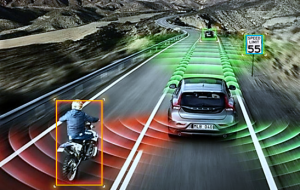(ThyBlackMan.com) Technology has given us a world we once thought was impossible, and it continues to expand into new areas of our lives. The future is approaching rapidly, and with it comes a new generation of automobiles that can communicate with each other, drive and park for their owners, avoid heavy traffic, brake to prevent an accident, and even pay fines. Are you ready for what is coming?
Accident Prevention
Nearly 33,000 people annually are killed in automobile accidents, and thousands more receive life-altering injuries. Ninety-percent of these accidents are caused by human error. The logical thinking in the technology field is to replace human drivers with computer controlled robots. These robots will not look like a human sitting in the driver’s seat, but they will be computers that control speed, lane changes, and all other driving and navigation decisions.
Technicians believe the best way to program robots to drive is to copy human actions. By following this protocol, it might make it easier for individuals to turn over their driving control and blend into and interact in traffic situations where human intuition is  helpful. The most useful aspects of autonomous vehicles are the non-human attributes.
helpful. The most useful aspects of autonomous vehicles are the non-human attributes.
Self-driving cars cannot be distracted by phone calls, texting, eating, crying babies, dropped cigarettes, and they can’t get drunk. For these reasons alone, the automotive industry believes thousands of lives will be saved every year.
Getting Humans To Accept Self-Driving Cars
Long before they reach the age required to get a driver’s license, boys and girls dream about the car they will own some day. Passing the driver’s license exam is the teenage rite of passage. Young adults will be the most difficult drivers to convince that self-driving cars are the wave of the future.
Introducing the robotic driving concepts in school, before teens reach the age they can drive, may ease them into the idea that self-driving cars are the best form of personal transportation. According to Wired, adult drivers will also be hard to convince to purchase self-driving cars.
Giving up the secure feeling that comes with controlling your car can be unnerving. Letting go of the wheel and trusting the accelerator, brakes, and steering to safely perform every time is a challenge to current human thinking.
Insurance Company Influence
Insurance companies may be the catalyst to convince people to try self-driving cars. Eliminating human error will reduce accident deaths and injuries dramatically, and there will be fewer cars damaged or totalled. Insurance companies will save millions of dollars every year. It stands to reason that the insurance premiums for self-driving cars will be considerably less than those still driven by humans.
The self-driving car cannot be affected by human actions or emotions, which might be the direct cause of a vehicle crash.
Accidents caused by drunk drivers could conceivably be eliminated after a period of time. Insurance companies see their liabilities reduced substantially when accidents caused by reckless driving and driver distractions, such as a crying baby, phone call, text message, eating, talking to passengers, and other distractions.
While self-driving cars won’t eliminate all accidents, such as a deer darting out of the trees in front of a car, mechanical failures, and storm related crashes, the majority of those caused by driver error will be drastically reduced.
Cars Will Not Need Humans
David Drake, of LDJ Capital, in an article written for VentureBeat stated, “In less than a generation, the car, as we know it, will become a 3D printed smartphone on wheels.” The time is coming when the car will be in full charge of your trip to work, the doctor, school, and shopping.
According to an article in The Atlantic, as technology provides a continual flow of safety improvements, passengers will feel very comfortable and relaxed as their chauffeur-less car transports them to their various destinations. Your car’s software will make great use of the Internet.
Ambulances and other emergency service vehicles will be able to communicate with software-enhanced with the traffic signal network to open a safe pathway for them to pass through intersections without interruption.
Eventually, there will be no more human drivers behind the wheel, and future generations will never know the experience of operating a car or truck. There will still be occasional accidents because software can fail, but major highways will be redesigned to accommodate self-driving cars.
Your grandchildren may laugh to think you had to manage driving on your own, while they sit back and relax on their commute to the office.
Staff Writer; Calvin Smith




















Leave a Reply